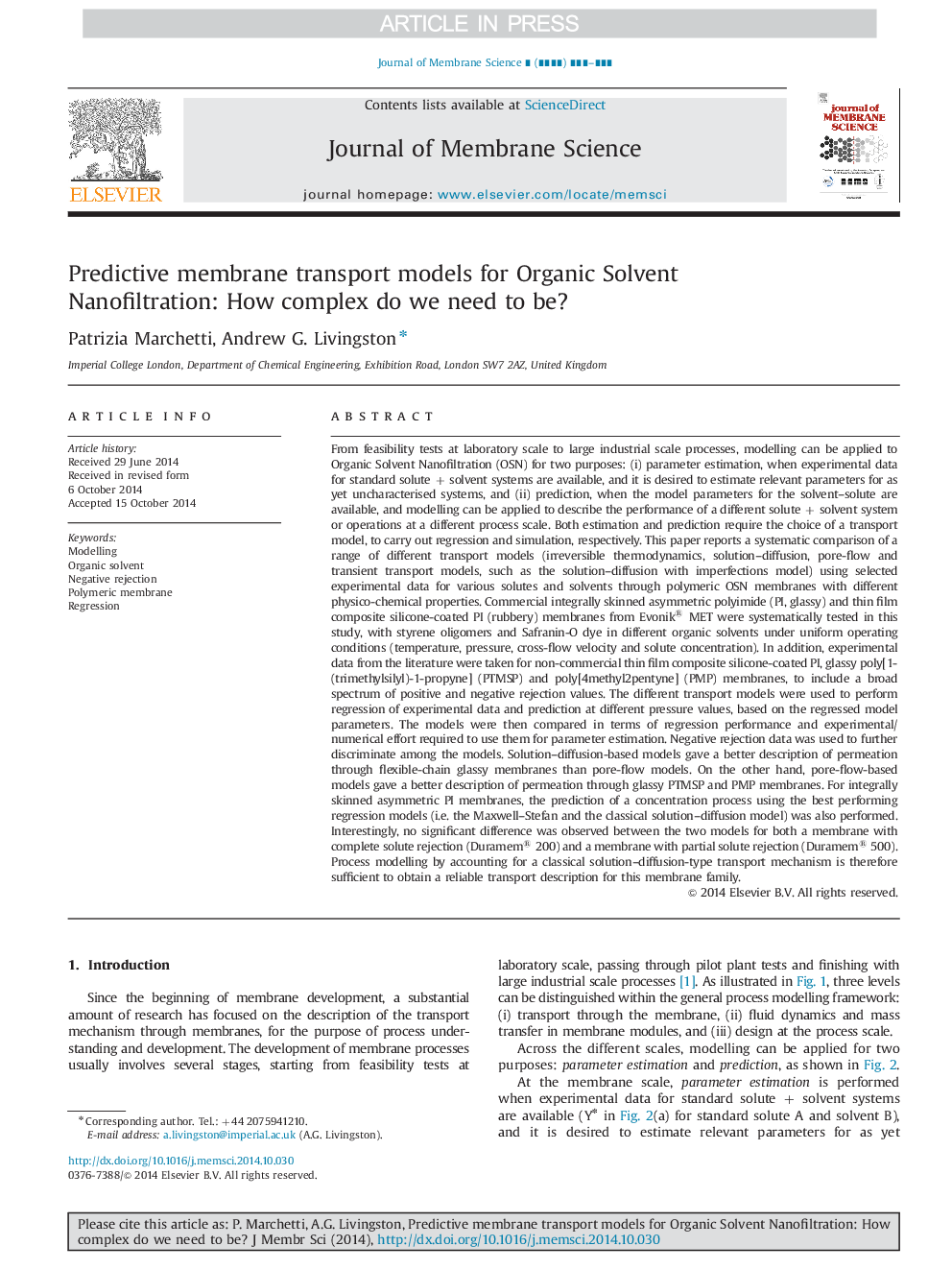| کد مقاله | کد نشریه | سال انتشار | مقاله انگلیسی | نسخه تمام متن |
|---|---|---|---|---|
| 7021755 | 1456023 | 2015 | 24 صفحه PDF | دانلود رایگان |
عنوان انگلیسی مقاله ISI
Predictive membrane transport models for Organic Solvent Nanofiltration: How complex do we need to be?
ترجمه فارسی عنوان
مدل های حمل ونقل پیشگیرانه برای نانوفیلتراسیون حلال های آلی: ما چگونه باید پیچیده باشیم؟
دانلود مقاله + سفارش ترجمه
دانلود مقاله ISI انگلیسی
رایگان برای ایرانیان
کلمات کلیدی
مدل سازی، حلال الی، رد منفی، غشای پلیمری، پسرفت،
موضوعات مرتبط
مهندسی و علوم پایه
مهندسی شیمی
تصفیه و جداسازی
چکیده انگلیسی
From feasibility tests at laboratory scale to large industrial scale processes, modelling can be applied to Organic Solvent Nanofiltration (OSN) for two purposes: (i) parameter estimation, when experimental data for standard solute + solvent systems are available, and it is desired to estimate relevant parameters for as yet uncharacterised systems, and (ii) prediction, when the model parameters for the solvent-solute are available, and modelling can be applied to describe the performance of a different solute + solvent system or operations at a different process scale. Both estimation and prediction require the choice of a transport model, to carry out regression and simulation, respectively. This paper reports a systematic comparison of a range of different transport models (irreversible thermodynamics, solution-diffusion, pore-flow and transient transport models, such as the solution-diffusion with imperfections model) using selected experimental data for various solutes and solvents through polymeric OSN membranes with different physico-chemical properties. Commercial integrally skinned asymmetric polyimide (PI, glassy) and thin film composite silicone-coated PI (rubbery) membranes from Evonik® MET were systematically tested in this study, with styrene oligomers and Safranin-O dye in different organic solvents under uniform operating conditions (temperature, pressure, cross-flow velocity and solute concentration). In addition, experimental data from the literature were taken for non-commercial thin film composite silicone-coated PI, glassy poly[1-(trimethylsilyl)-1-propyne] (PTMSP) and poly[4methyl2pentyne] (PMP) membranes, to include a broad spectrum of positive and negative rejection values. The different transport models were used to perform regression of experimental data and prediction at different pressure values, based on the regressed model parameters. The models were then compared in terms of regression performance and experimental/numerical effort required to use them for parameter estimation. Negative rejection data was used to further discriminate among the models. Solution-diffusion-based models gave a better description of permeation through flexible-chain glassy membranes than pore-flow models. On the other hand, pore-flow-based models gave a better description of permeation through glassy PTMSP and PMP membranes. For integrally skinned asymmetric PI membranes, the prediction of a concentration process using the best performing regression models (i.e. the Maxwell-Stefan and the classical solution-diffusion model) was also performed. Interestingly, no significant difference was observed between the two models for both a membrane with complete solute rejection (Duramem® 200) and a membrane with partial solute rejection (Duramem® 500). Process modelling by accounting for a classical solution-diffusion-type transport mechanism is therefore sufficient to obtain a reliable transport description for this membrane family.
ناشر
Database: Elsevier - ScienceDirect (ساینس دایرکت)
Journal: Journal of Membrane Science - Volume 476, 15 February 2015, Pages 530-553
Journal: Journal of Membrane Science - Volume 476, 15 February 2015, Pages 530-553
نویسندگان
Patrizia Marchetti, Andrew G. Livingston,
